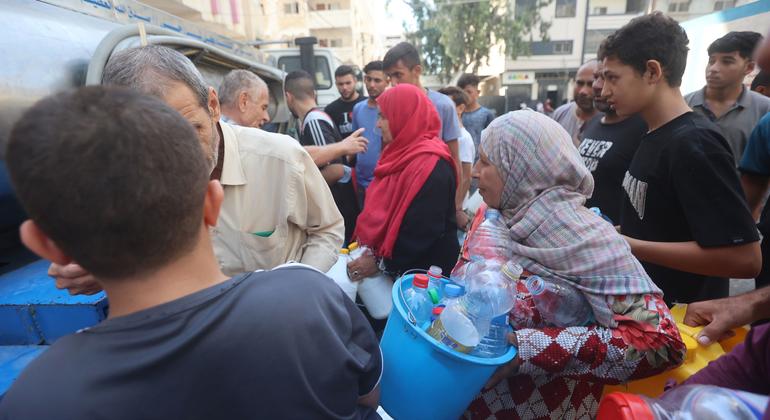

More than 10 months into the war in Gaza, sparked by Hamas-led terror attacks in Israel that left some 1,250 dead and more than 250 taken hostage, nearly all Gazans have been displaced at least once – and often multiple times – by repeated orders to evacuate and intense Israeli bombardment.
“Nowhere in the Gaza Strip is safe…It does feel like people are waiting for death,” said Louise Wateridge, spokesperson for the UN agency for Palestine refugees, in an online message on X. “Areas that were (in) the humanitarian zone are now the front line”, she told UN News, noting also that Gazans “are never more than a few blocks away from the front line now”.
Crucial axis road cut
In its latest update on the emergency, the UN aid coordination office, OCHA, insisted that the “relentless” hostilities and repeated evacuation orders in Gaza have continued to constrain relief operations “already hampered by access constraints, fuel shortages, and other challenges”.
OCHA reported that parts of Salah ad Din road – a crucial passage for humanitarian missions from south to north – were caught up in an evacuation order by the Israeli authorities issued on Saturday for Deir al Balah. “This has made it nearly impossible for aid workers to move along this key route,” it noted. The Israeli Defense Forces issued a new order affecting neighbourhoods in the central city on Wednesday morning.
Gaza’s coastal road “is not a viable alternative” anymore, OCHA continued, explaining that the beaches along this route are “crowded with makeshift shelters” for Palestinians forcibly uprooted from their homes.
“As a result, convoy movements along the coastal road are extremely slow, and critical supplies and services – such as water trucking – are not reaching people in need at anywhere near the scale required,” the UN aid office warned.
Tanks in Khan Younis
In Khan Younis where Israeli tanks have returned, UNRWA expressed growing concerns that key facilities in areas of the southern city slated for evacuation may soon be damaged or destroyed.
These include the just-restored water pumping station in Khan Younis that serves some 100,000 people, the UNRWA Japanese Health Center in Khan Younis that reopened last month – and which is intended to play a key role in the upcoming polio vaccination campaign – and the Khan Younis Training Centre, a large facility now used as a warehouse to store humanitarian supplies.
“Without that warehouse, we cannot bring aid in and put it anywhere. There’s there’s no warehouses left,” explained Ms. Wateridge.
“You’ve got water, you’ve got medicine and vaccinations, and you’ve got distribution; if any of these facilities gets damaged and destroyed, that is going to be disastrous,” she told UN News.